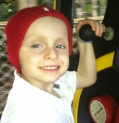Social Attention in Pediatric Brain Tumor Survivors and Children with Autism Spectrum Disorders
Background
Pediatric brain tumor survivors (PBTS) have difficulties with social competence. Compared to peers and other survivors, PBTS have fewer close friends, lower rates of peer acceptance and greater social isolation. While the social impairments of PBTS have similarities to those of youth with autism spectrum disorder (ASD), the factors contributing to these difficulties are not well understood. Deficits in visual social attention, or where gaze is directed in social situations, have been implicated in ASD. Compared to typically developing (TD) individuals, youth with ASD attend less to socially-relevant stimuli during eye-tracking paradigms (ETP). Evidence suggests that the infratentorial region contributes to the development of the neurobehavioral abnormalities of ASD. Youth who have resections for infratentorial tumors (IT) show impairments similar to those in ASD, including social gaze.
Project Goal
This research will compare the social attention of PBTS, youth with ASD and TD youth. It will also examine associations between social attention, facial expression recognition and social adjustment. This study will use an existing database from collaborators at the Center for Autism Research at The Children's Hospital of Philadelphia (60 youth with ASD and 52 TD youth) and novel data collection with sixty PBTS (30 IT and 30 supratentorial survivors). PBTS (ages of 6-17 to match existing samples) will be at least 2 years from the end of tumor-directed treatment. Eye gaze patterns for social areas of interest on ETPs will be compared across groups and associations between fixation patterns, facial expression recognition and social adjustment outcomes will be examined.

